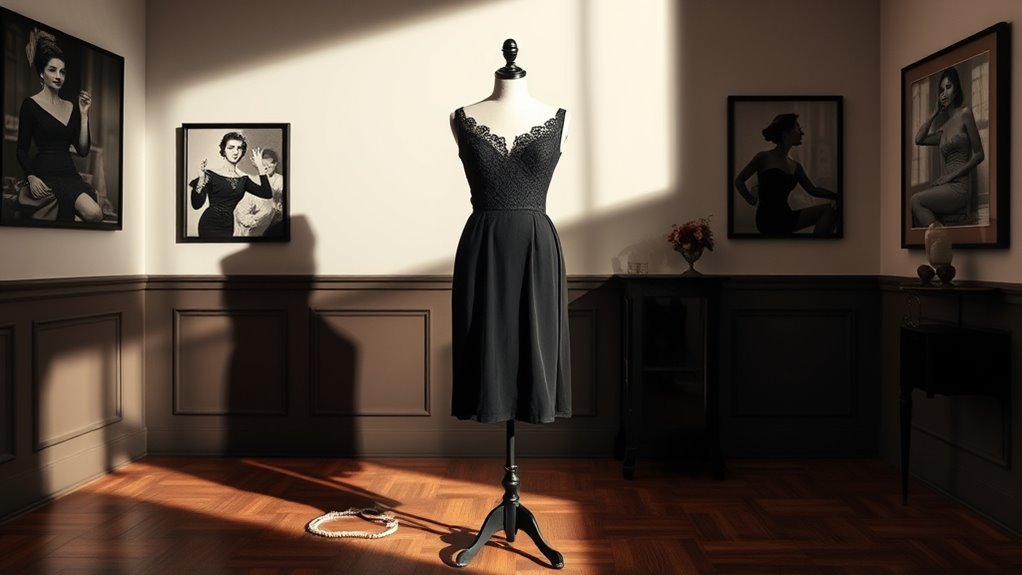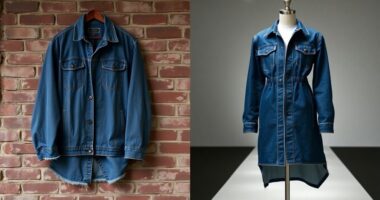The little black dress has evolved markedly over time. Initially linked to mourning in the Victorian era, it transformed into a symbol of elegance with Coco Chanel’s 1926 design that made it accessible to all. This versatile piece can suit any occasion, offering chic sophistication without excess. It’s more than just a staple; it’s a timeless fashion choice that transcends generations. If you’re curious about its impact on fashion and society, there’s much more to explore!
Key Takeaways
- The Little Black Dress (LBD) evolved from Victorian mourning attire to a symbol of sophistication and wealth in early modern Europe.
- Coco Chanel revolutionized the LBD in 1926, making it accessible and establishing it as a timeless staple in women’s fashion.
- The LBD’s versatility allows it to be styled for various occasions, appealing to women across different socioeconomic backgrounds.
- Its simplicity promotes elegance and has influenced fashion norms by proving that understated designs can be sophisticated and chic.
- The LBD’s economic impact includes democratizing fashion, offering an affordable stylish option, and reinforcing the importance of timeless wardrobe staples.

When you think of timeless fashion staples, the little black dress (LBD) certainly comes to mind. This iconic piece has a rich history that stretches back through the ages. In the Victorian Era, black dresses were primarily worn by widows as an indication of mourning, while the working class appreciated the color for its stain-hiding properties. As society evolved, black evolved into a symbol of wealth among the upper class in early modern Europe, signaling sophistication and status.
By the 1890s, black dresses began to emerge as fashionable items for society matrons, marking a shift in how people viewed this once-practical color. Before this change, black dresses often served as uniforms for service workers, making their rise to fashion prominence even more significant. The Romantic Era saw figures like Byron and Shelley romanticizing black, associating it with artistry and elegance.
The game-changer in the LBD’s history came in 1926 when Coco Chanel debuted her simple black dress design in *American Vogue*, famously dubbed “Chanel’s Ford.” Chanel aimed to make fashion accessible and affordable for women of all classes, helping to redefine black from a color of mourning to one of chic sophistication. Her design became a standard in modern women’s wardrobes, symbolizing elegance and simplicity that transcended social barriers.
Coco Chanel revolutionized fashion in 1926 with the LBD, transforming black into a symbol of chic sophistication for all women.
The versatility of the LBD is what truly sets it apart. You can dress it up or down for almost any occasion, making it an essential piece in every woman’s closet. With the right accessories, the LBD adapts to various styles and seasons, ensuring its continued popularity across generations. This adaptability emphasizes affordability, making it a staple that appeals to women regardless of their socioeconomic status.
Culturally, the LBD has gained universal acceptance, representing timeless fashion that remains relevant despite changing trends. It embodies elegance without excessive embellishment, influencing fashion norms by proving that simplicity can be sophisticated. Chanel’s influence on the LBD also promoted social equality, showcasing how fashion can bridge class divides. Additionally, the rise of sustainable brands has led to a growing focus on eco-friendly options in the fashion industry, further enhancing the LBD’s appeal as a timeless choice.
The economic impact of the LBD on the fashion industry can’t be underestimated. By offering a chic yet affordable option, it transformed perceptions of black in fashion and established a global recognition of the LBD as a fashion icon.
As you consider your wardrobe, remember that the little black dress is more than just a clothing item; it’s a piece of history that symbolizes elegance, versatility, and social progress.
Frequently Asked Questions
Who Invented the Little Black Dress?
You might be surprised to learn that Coco Chanel is credited with inventing the little black dress.
In the 1920s, she transformed women’s fashion by introducing this elegant, versatile piece. Chanel’s design made simplicity and sophistication accessible to everyone, breaking away from the ornate styles of the time.
The little black dress quickly became a wardrobe staple, symbolizing both chicness and practicality, and it continues to influence modern fashion today.
What Materials Are Commonly Used for Little Black Dresses?
Imagine sliding into a soft, luxurious silk LBD that glimmers under the lights, or donning a chic cotton blend that feels effortlessly comfortable.
You’ll often find materials like satin, crepe, and jacquard adding elegance to your evening look.
For a more casual vibe, think breathable linen or stretchy fabrics that move with you.
Whether you choose opulence or practicality, the fabric you select shapes your style and confidence in any setting.
How Should I Care for My Little Black Dress?
To care for your little black dress, always wash it in cold water to prevent fading.
Use a delicate cycle and a detergent designed for dark fabrics.
Try to limit washing to when it’s necessary, and pre-treat any stains before washing.
Air dry your dress away from direct sunlight, and consider storing it in a fabric bag to protect it.
Regularly check for wear and gently brush delicate fabrics to keep them looking fresh.
Can the Little Black Dress Be Worn Year-Round?
Think of the little black dress as your trusty umbrella—it’s perfect for any weather!
You can absolutely wear it year-round. In summer, pair it with sandals and light accessories; in fall, layer with cardigans and boots; in winter, add tights and a warm scarf; and in spring, brighten it up with pastels.
No matter the season, the LBD adapts to your style, making it a timeless staple in your wardrobe.
What Accessories Pair Well With a Little Black Dress?
When you’re accessorizing a little black dress, think statement jewelry like oversized earrings or chunky necklaces for instant glamour.
A colorful scarf can add warmth and vibrancy, while an embellished belt enhances your silhouette.
Don’t forget a bold handbag to shift focus, and consider hats or hair accessories for extra flair.
For footwear, high heels elevate your look, but don’t hesitate to opt for stylish flats or trendy boots for a more casual vibe.
Conclusion
In the domain of refined fashion, the little black dress reigns supreme. Its timeless charm and chic simplicity continue to captivate countless closets. From Coco Chanel’s groundbreaking brilliance to modern interpretations, this versatile garment’s legacy lives on. You’ve got the power to personalize your own LBD, making it a canvas for creativity. So, whether you’re dressing down for a casual coffee or dazzling at a dinner, remember: the little black dress is your stylish secret to stunning confidence.










